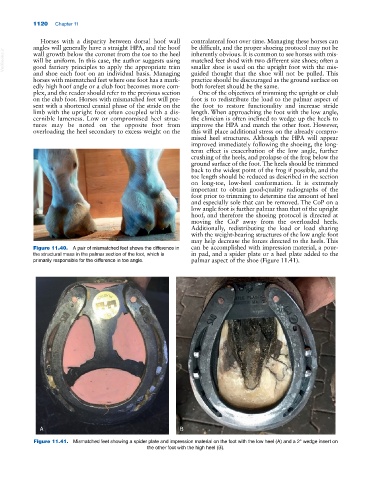Page 1154 - Adams and Stashak's Lameness in Horses, 7th Edition
P. 1154
1120 Chapter 11
Horses with a disparity between dorsal hoof wall contralateral foot over time. Managing these horses can
angles will generally have a straight HPA, and the hoof be difficult, and the proper shoeing protocol may not be
VetBooks.ir will be uniform. In this case, the author suggests using matched feet shod with two different size shoes; often a
inherently obvious. It is common to see horses with mis
wall growth below the coronet from the toe to the heel
smaller shoe is used on the upright foot with the mis
good farriery principles to apply the appropriate trim
and shoe each foot on an individual basis. Managing guided thought that the shoe will not be pulled. This
horses with mismatched feet where one foot has a mark practice should be discouraged as the ground surface on
edly high hoof angle or a club foot becomes more com both forefeet should be the same.
plex, and the reader should refer to the previous section One of the objectives of trimming the upright or club
on the club foot. Horses with mismatched feet will pre foot is to redistribute the load to the palmar aspect of
sent with a shortened cranial phase of the stride on the the foot to restore functionality and increase stride
limb with the upright foot often coupled with a dis length. When approaching the foot with the low angle,
cernible lameness. Low or compromised heel struc the clinician is often inclined to wedge up the heels to
tures may be noted on the opposite foot from improve the HPA and match the other foot. However,
overloading the heel secondary to excess weight on the this will place additional stress on the already compro
mised heel structures. Although the HPA will appear
improved immediately following the shoeing, the long‐
term effect is exacerbation of the low angle, further
crushing of the heels, and prolapse of the frog below the
ground surface of the foot. The heels should be trimmed
back to the widest point of the frog if possible, and the
toe length should be reduced as described in the section
on long‐toe, low‐heel conformation. It is extremely
important to obtain good‐quality radiographs of the
foot prior to trimming to determine the amount of heel
and especially sole that can be removed. The CoP on a
low angle foot is further palmar than that of the upright
hoof, and therefore the shoeing protocol is directed at
moving the CoP away from the overloaded heels.
Additionally, redistributing the load or load sharing
with the weight‐bearing structures of the low angle foot
may help decrease the forces directed to the heels. This
Figure 11.40. A pair of mismatched feet shows the difference in can be accomplished with impression material, a pour‐
the structural mass in the palmar section of the foot, which is in pad, and a spider plate or a heel plate added to the
primarily responsible for the difference in toe angle. palmar aspect of the shoe (Figure 11.41).
A B
Figure 11.41. Mismatched feet showing a spider plate and impression material on the foot with the low heel (A) and a 2° wedge insert on
the other foot with the high heel (B).

